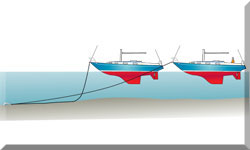- Home
- Sails
- Dacron Sail Cloth
- Dacron Sail Finishing
Dacron Sail Finishing for Optimal Performance and Durability
Dacron finishing is a crucial step in sailcloth manufacturing, enhancing the fabric's properties beyond its inherent weave. This article aims to demystify the various Dacron finishing techniques, empowering you to understand how they impact your sail's performance, durability, and even its appearance.
The Importance of Dacron Finishing
Finishing processes are essential for protecting Dacron from the harsh realities of the marine environment. Without proper finishing, Dacron sails would quickly succumb to the damaging effects of UV radiation, abrasion, and mildew.
Prolonged exposure to sunlight can break down the polyester fibers, leading to a loss of strength and shape.
Abrasion from rigging, spreaders, and other surfaces can wear down the fabric, compromising its integrity.
Mildew, thriving in damp conditions, can stain and weaken the sailcloth. Finishing provides a protective barrier, extending the lifespan of your sails and ensuring they perform optimally for years to come.
Beyond protection, finishing plays a vital role in enhancing sail performance. It can improve sail shape retention by reducing stretch and minimizing distortion under load. It also controls air permeability, which is crucial for maintaining the sail's designed shape and efficiency.
Lastly, finishing significantly impacts the sail's aesthetics. It affects the sail's luster, smoothness, and overall visual appeal. A well-finished sail will not only perform better but also look more appealing on the water.
Resin Treatments
Resin treatments are a common method of finishing Dacron sailcloth. They involve applying a layer of resin to the fabric, which enhances its properties and provides a protective barrier. Various types of resins are used, each with its own unique properties and benefits:
- Acrylic resins offer good UV resistance and flexibility, making them suitable for cruising sails.
- Polyurethane resins provide excellent abrasion resistance and water repellency, ideal for sails exposed to harsh conditions.
- Epoxy resins offer superior strength and stiffness, often used in performance sails.
The application of these resins can occur through various methods, including dipping the fabric into a resin bath, spraying the resin onto the fabric, or coating the fabric with a resin layer.
The application method affects the penetration and uniformity of the resin, influencing the final properties of the sailcloth. Resin treatments enhance UV resistance, protecting the sail from sun damage.
They also improve water repellency, preventing the sail from becoming waterlogged and heavy. Furthermore, they increase abrasion resistance, making the sail more durable and resistant to wear and tear. Resin treatments also affect sail stiffness and shape retention, providing a more stable and responsive sail.
Calendering
Calendering is another common finishing process, that involves passing the Dacron fabric through heated rollers under pressure. This process flattens and compacts the fabric yarns, resulting in a smoother, denser surface.
Calendering reduces air permeability, which is crucial for maintaining sail shape and efficiency. It also increases smoothness, reducing friction and improving airflow over the sail. Additionally, it enhances luster, giving the sail a polished and refined appearance.
Calendering also affects sail stiffness and shape retention, providing a more stable and responsive sail.
Variations in calendering are achieved by adjusting the pressure and temperature of the rollers. Higher pressure and temperature result in a denser, smoother finish, while lower pressure and temperature produce a softer, more flexible finish.
Different degrees of calendering are used to achieve specific sail properties, depending on the intended use of the sail.
Comparing Resin Treatments and Calendering
Resin treatments and calendering offer distinct benefits, and the choice between them depends on your sailing priorities. Resin treatments prioritize durability, providing a protective barrier against UV radiation, abrasion, and mildew.
Calendering, on the other hand, prioritizes performance, enhancing smoothness, reducing air permeability, and improving shape retention. In many cases, resin treatments and calendering are used in combination to achieve optimal results. For example, a sailcloth may be resin-treated for UV protection and then calendered to enhance its performance characteristics.
This combination provides the best of both worlds, ensuring both durability and performance.
Choosing the Right Finish
Selecting the right finish for your Dacron sails depends on several factors, including your boat type, sailing style, typical sailing conditions, desired sail performance, and budget:
- For casual cruising in moderate conditions, a resin-treated sail may suffice. If you prioritize performance and sail in strong winds, a calendered sail may be more suitable.
- For serious performance cruising or racing, a combination of resin treatment and calendering may be the best option.
It is always best to consult with a reputable sailmaker, who can assess your specific needs and recommend the most appropriate finish for your sailing style and boat.
Proper maintenance is also crucial for extending the life of your sails, regardless of the finish. Regular washing, drying, and storing will help prevent damage and ensure optimal performance.
.........................
I wrote this article using GPT-4, OpenAI’s large-scale language-generation model, as a research assistant to gather information, summarize research findings, and provide suggestions for the content and structure of the article.
Dick McClary, creator and owner of sailboat-cruising.com
.........................
Recent Articles
-
Wheel-Steering Autopilots: Your Questions Answered...
Apr 18, 25 03:45 PM
Whatever your question, you should find the answer here -
Tiller Pilots: Your Questions Answered...
Apr 18, 25 08:18 AM
Got a question about sailboat tiller pilots? Odds are, you'll find the answer here -
Is Marine SSB Still Used?
Apr 15, 25 02:05 PM
You'll find the answer to this and other marine SSB-related questions right here...












